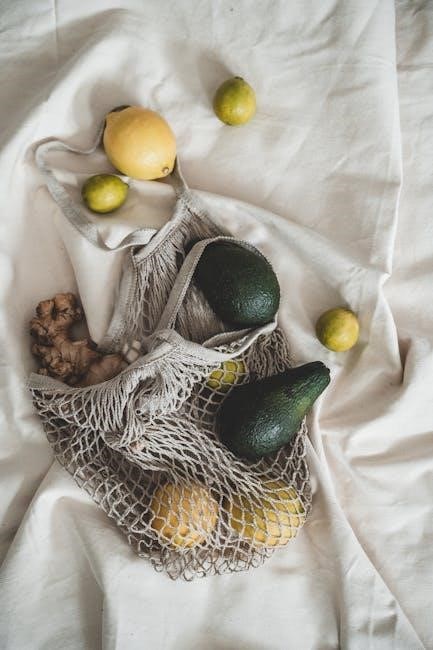A low purine diet focuses on managing gout by reducing uric acid buildup through dietary choices. It emphasizes consuming foods with minimal purine content to prevent flare-ups and support overall health.

1.1 What Are Purines?
Purines are organic compounds found in various foods and the human body, playing a role in DNA structure. They are broken down into uric acid, which, in excess, can lead to gout. Foods high in purines, such as organ meats and certain seafood, increase uric acid levels, potentially triggering gout attacks. A low purine diet helps manage this by limiting intake of these foods, reducing uric acid buildup. Purines are naturally present in the body and obtained from the diet, but excessive consumption can disrupt uric acid metabolism, leading to health issues like gout; Understanding purine content in foods is crucial for designing an effective low purine diet to prevent or manage gout symptoms and promote overall well-being.
1.2 Importance of a Low Purine Diet for Gout Management
A low purine diet is essential for managing gout, as it helps reduce uric acid levels in the body. Elevated uric acid can form sharp crystals in joints, causing pain and inflammation. By limiting purine-rich foods, individuals can lower their risk of gout flare-ups and improve overall health. This dietary approach is particularly beneficial for those with hyperuricemia or a history of gout attacks. It not only alleviates symptoms but also supports long-term joint health. While medication is often necessary, a low purine diet complements treatment by addressing the root cause of uric acid buildup. Balanced nutrition and moderation are key to sustaining this diet and enhancing quality of life for gout patients.

Low Purine Foods List
A low purine diet includes fruits, vegetables, whole grains, lean proteins, and low-fat dairy. Examples are berries, citrus fruits, leafy greens, and whole grains like rice and oats. Eggs, nuts, and low-fat dairy are also suitable. These foods help maintain balanced nutrition while managing purine intake.
2.1 Fruits and Vegetables Low in Purines
Fruits and vegetables are excellent choices for a low purine diet. Most fruits, such as berries, citrus fruits, and apples, are naturally low in purines. Vegetables like spinach, broccoli, and cucumbers are also ideal. These foods are rich in vitamins, minerals, and antioxidants, making them a healthy addition to meals. Incorporating a variety of colorful fruits and vegetables ensures a balanced intake of nutrients while keeping purine levels low. Additionally, fruits like bananas and vegetables like carrots are great options for snacks or side dishes. These foods not only support gout management but also promote overall well-being. Including a wide range of fruits and vegetables in your diet can help maintain a nutritious and flavorful meal plan.
2.2 Low Purine Protein Sources
Protein is essential for a healthy diet, but choosing low purine options is crucial for managing gout. Eggs, nuts, and peanut butter are excellent low purine protein sources. Low-fat dairy products, such as milk, cheese, and yogurt, are also ideal. Tofu and other plant-based proteins are great alternatives to meat. Fish and poultry should be consumed in moderation, while avoiding high purine meats like organ meats and certain fish. Balancing protein intake with these low purine options helps reduce uric acid levels. Portion control is key, as even low purine proteins can contribute to uric acid buildup if overeaten. Incorporating these proteins ensures a balanced diet while minimizing gout flare-ups.
2.3 Whole Grains and Starchy Foods Suitable for a Low Purine Diet
Whole grains and starchy foods are excellent additions to a low purine diet, providing essential nutrients and fiber. Oatmeal, wheat bran, and whole-grain cereals are ideal choices. Rice, quinoa, and barley are also low in purines and can be consumed regularly. Starchy vegetables like potatoes, corn, and peas are safe options. Whole-grain bread and pasta should replace refined versions to maintain nutritional balance. Moderation is key, as overconsumption of starchy foods can still affect uric acid levels. Incorporating these foods helps maintain energy levels while supporting gout management. They also contribute to a balanced diet, ensuring overall health without triggering gout flare-ups.
2.4 Dairy Products and Their Purine Content
Dairy products are generally low in purines, making them a great addition to a low purine diet. Low-fat and fat-free options like milk, cheese, and ice cream are excellent choices. Skim milk and low-fat yogurt are particularly recommended due to their minimal purine content. These products provide essential nutrients like calcium and protein without significantly increasing uric acid levels. Moderation is still key, as overconsumption of any food can impact overall health. Incorporating dairy into meals helps maintain dietary balance while supporting gout management. They are also versatile, fitting easily into breakfast, snacks, and main dishes. Choosing low-fat dairy ensures a healthier profile, aligning with the goals of a low purine diet.

Moderate and High Purine Foods to Be Aware Of
Understanding moderate and high purine foods is crucial for managing gout. These foods can trigger uric acid buildup, potentially causing flare-ups. Awareness helps in making informed dietary choices.
3.1 Understanding Moderate Purine Foods
Moderate purine foods contain purines in amounts that may not trigger gout flare-ups but should still be consumed cautiously. They include certain meats, fish, and vegetables. Eating them occasionally, in small portions, is generally safe but requires monitoring personal tolerance. For instance, foods like turkey, chicken, and some seafood fall into this category. It’s essential to balance these with low-purine options to maintain uric acid levels. Portion control is key, as overconsumption can elevate uric acid. Consulting a healthcare provider or dietitian helps tailor intake based on individual needs and gout severity. Awareness of these foods allows for a balanced diet without overexposure to purines.
3.2 High Purine Foods to Avoid
High purine foods significantly increase uric acid levels, worsening gout symptoms. These include organ meats like liver and kidney, as well as certain seafood such as sardines, anchovies, and mackerel. Red meats like beef and pork, especially in large portions, and processed meats like bacon and sausages, are also high in purines. Some fish, such as herring and trout, fall into this category. Alcohol, particularly beer and liquor, can also raise uric acid. To manage gout effectively, it’s crucial to avoid or severely limit these foods. Even small amounts can trigger flare-ups in sensitive individuals. A strict avoidance of high purine foods is often necessary to maintain healthy uric acid levels and prevent gout attacks.

Benefits of a Low Purine Diet
A low purine diet helps prevent gout attacks and reduces uric acid levels. It promotes balanced nutrition and supports long-term health, minimizing disease risks.
4.1 Reducing Gout Flare-Ups Through Diet
A low purine diet plays a crucial role in reducing gout flare-ups by minimizing uric acid production. By avoiding high-purine foods like red meat and seafood, individuals can lower their uric acid levels, which helps prevent crystal formation in joints. Incorporating plant-based foods, whole grains, and lean proteins can further support this goal. Moderation in alcohol consumption, especially beer and liquor, is also essential. Staying hydrated and maintaining a healthy weight additionally contribute to managing gout symptoms. This dietary approach not only reduces the frequency of flare-ups but also improves overall well-being. Regularly reviewing and adjusting the diet with a healthcare provider ensures the best outcomes for managing gout effectively.

Practical Tips for Following a Low Purine Diet
Plan meals around low-purine foods, shop for fresh produce, and read labels to ensure compliance with dietary guidelines. Maintain a balanced intake and stay consistent for best results.

5.1 Meal Planning and Grocery Shopping Strategies
Effective meal planning is crucial for adhering to a low purine diet. Start by creating a weekly menu, focusing on low purine foods like fruits, vegetables, whole grains, and lean proteins. Refer to a low purine foods list to guide your choices. When grocery shopping, prioritize fresh produce, low-fat dairy, and plant-based protein sources. Avoid high-purine items such as organ meats, seafood, and alcohol. Stock your pantry with staples like brown rice, quinoa, and oats. Planning ahead ensures that you always have healthy, gout-friendly options available, making it easier to maintain a balanced and nutritious diet.
5.2 Reading Food Labels for Purine Content
Reading food labels is essential for managing purine intake, especially when following a low purine diet. While purine content isn’t always listed explicitly, familiarize yourself with high-purine ingredients like organ meats, seafood, and alcohol. Check for terms such as “meat extract” or “broth,” which indicate higher purine levels. Opt for products labeled as “low fat” or “plant-based,” as these tend to have lower purine content. Avoid processed foods containing anchovies, sardines, or liver, which are known to be high in purines. When in doubt, consult a healthcare provider or dietitian for personalized guidance. This proactive approach ensures you make informed choices aligned with your dietary goals.
Adopting a low purine diet is a crucial step in managing gout and reducing uric acid buildup. By focusing on low purine foods like fruits, vegetables, whole grains, and lean proteins, individuals can significantly lower the risk of gout flare-ups. Avoiding high purine foods such as organ meats and certain seafood is essential for maintaining long-term health. A well-planned low purine diet not only helps in managing gout but also promotes overall well-being. Always consult with a healthcare provider or dietitian to tailor the diet to your specific needs and ensure the best outcomes for your health.
